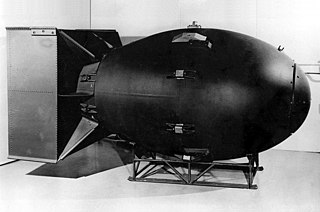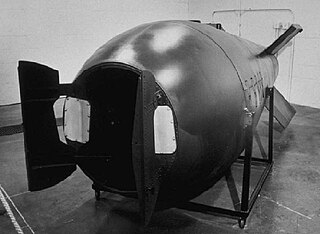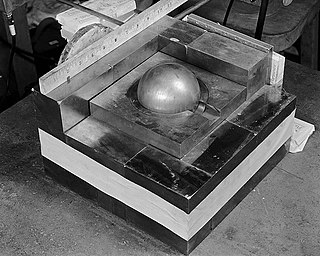
"Fat Man" was the codename for the type of nuclear bomb the United States detonated over the Japanese city of Nagasaki on 9 August 1945. It was the second of the only two nuclear weapons ever used in warfare, the first being Little Boy, and its detonation marked the third nuclear explosion in history. It was built by scientists and engineers at Los Alamos Laboratory using plutonium from the Hanford Site, and was dropped from the Boeing B-29 Superfortress Bockscar piloted by Major Charles Sweeney.

Little Boy was the type of atomic bomb dropped on the Japanese city of Hiroshima on 6 August 1945 during World War II, making it the first nuclear weapon used in warfare. The bomb was dropped by the Boeing B-29 Superfortress Enola Gay piloted by Colonel Paul W. Tibbets Jr., commander of the 509th Composite Group, and Captain Robert A. Lewis. It exploded with an energy of approximately 15 kilotons of TNT (63 TJ) and caused widespread death and destruction throughout the city. The Hiroshima bombing was the second man-made nuclear explosion in history, after the Trinity nuclear test.

Nuclear weapon designs are physical, chemical, and engineering arrangements that cause the physics package of a nuclear weapon to detonate. There are three existing basic design types:

Operation Sandstone was a series of nuclear weapon tests in 1948. It was the third series of American tests, following Trinity in 1945 and Crossroads in 1946, and preceding Ranger. Like the Crossroads tests, the Sandstone tests were carried out at the Pacific Proving Grounds, although at Enewetak Atoll rather than Bikini Atoll. They differed from Crossroads in that they were conducted by the Atomic Energy Commission, with the armed forces having only a supporting role. The purpose of the Sandstone tests was also different: they were primarily tests of new bomb designs rather than of the effects of nuclear weapons. Three tests were carried out in April and May 1948 by Joint Task Force 7, with a work force of 10,366 personnel, of whom 9,890 were military.

Operation Greenhouse was the fifth American nuclear test series, the second conducted in 1951 and the first to test principles that would lead to developing thermonuclear weapons. Conducted at the new Pacific Proving Ground, on islands of the Enewetak Atoll, it mounted the devices on large steel towers to simulate air bursts. This series of nuclear weapons tests was preceded by Operation Ranger and succeeded by Operation Buster-Jangle.

Operation Teapot was a series of 14 nuclear test explosions conducted at the Nevada Test Site in the first half of 1955. It was preceded by Operation Castle, and followed by Operation Wigwam. Wigwam was, administratively, a part of Teapot, but it is usually treated as a class of its own. The aims of the operation were to establish military tactics for ground forces on a nuclear battlefield and to improve the nuclear weapons used for strategic delivery.

Yellow Sun was the first British operational high-yield strategic nuclear weapon warhead. The name refers only to the outer casing; the warhead was known as "Green Grass" in Yellow Sun Mk.1 and "Red Snow" in Yellow Sun Mk.2.

Ivy King was the largest pure-fission nuclear bomb ever tested by the United States. The bomb was tested during the Truman administration as part of Operation Ivy. This series of tests involved the development of very powerful nuclear weapons in response to the nuclear weapons program of the Soviet Union.
Joe 4 was an American nickname for the first Soviet test of a thermonuclear weapon on August 12, 1953, that detonated with a force equivalent to 400 kilotons of TNT. The proper Soviet terminology for the warhead was RDS-6s, Reaktivnyi Dvigatel Specialnyi, lit. 'Special Jet Engine'.

A boosted fission weapon usually refers to a type of nuclear bomb that uses a small amount of fusion fuel to increase the rate, and thus yield, of a fission reaction. The neutrons released by the fusion reactions add to the neutrons released due to fission, allowing for more neutron-induced fission reactions to take place. The rate of fission is thereby greatly increased such that much more of the fissile material is able to undergo fission before the core explosively disassembles. The fusion process itself adds only a small amount of energy to the process, perhaps 1%.

Gun-type fission weapons are fission-based nuclear weapons whose design assembles their fissile material into a supercritical mass by the use of the "gun" method: shooting one piece of sub-critical material into another. Although this is sometimes pictured as two sub-critical hemispheres driven together to make a supercritical sphere, typically a hollow projectile is shot onto a spike which fills the hole in its center. Its name is a reference to the fact that it is shooting the material through an artillery barrel as if it were a projectile.

The Mark 5 nuclear bomb and W5 nuclear warhead were a common core American nuclear weapon design, designed in the early 1950s and which saw service from 1952 to 1963.

The Mark 4 nuclear bomb was an American implosion-type nuclear bomb based on the earlier Mark 3 Fat Man design, used in the Trinity test and the bombing of Nagasaki. With the Mark 3 needing each individual component to be hand-assembled by only highly trained technicians under closely controlled conditions, the purpose of the Mark 4 was to produce an atomic weapon as a practical piece of ordnance. The Mark 4 Mod 0 entered the stockpile starting March 19, 1949 and was in use until 1953. With over 500 units procured, the Mark 4 was the first mass-produced nuclear weapon.

The Mark 6 nuclear bomb was an American nuclear bomb based on the earlier Mark 4 nuclear bomb and its predecessor, the Mark 3 Fat Man nuclear bomb design.

The Mark 11 nuclear bomb was an American nuclear bomb developed from the earlier Mark 8 nuclear bomb in the mid-1950s. Like the Mark 8, the Mark 11 was an earth-penetrating weapon, also known as a nuclear bunker buster bomb.

Orange Herald was a British nuclear weapon, tested on 31 May 1957. At the time it was reported as an H-bomb, although in fact it was a large boosted fission weapon and remains to date, the largest fission device ever detonated.
The Mark 13 nuclear bomb and its variant, the W-13 nuclear warhead, were experimental nuclear weapons developed by the United States from 1951 to 1954. The Mark 13 design was based on the earlier Mark 6 nuclear bomb design, which was in turn based on the Mark 4 nuclear bomb and the Mark 3 nuclear bomb used at the end of World War II.
Reactor-grade plutonium (RGPu) is the isotopic grade of plutonium that is found in spent nuclear fuel after the uranium-235 primary fuel that a nuclear power reactor uses has burnt up. The uranium-238 from which most of the plutonium isotopes derive by neutron capture is found along with the U-235 in the low enriched uranium fuel of civilian reactors.

A fizzle occurs when the detonation of a device for creating a nuclear explosion grossly fails to meet its expected yield. The bombs still detonate, however, the detonation is much less than anticipated. The cause(s) for the failure can be linked to improper design, poor construction, or lack of expertise. All countries that have had a nuclear weapons testing program have experienced some fizzles. A fizzle can spread radioactive material throughout the surrounding area, involve a partial fission reaction of the fissile material, or both. For practical purposes, a fizzle can still have considerable explosive yield when compared to conventional weapons.

The pit, named after the hard core found in fruits such as peaches and apricots, is the core of an implosion nuclear weapon – the fissile material and any neutron reflector or tamper bonded to it. Some weapons tested during the 1950s used pits made with U-235 alone, or in composite with plutonium, but all-plutonium pits are the smallest in diameter and have been the standard since the early 1960s.

















